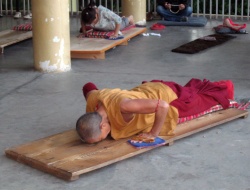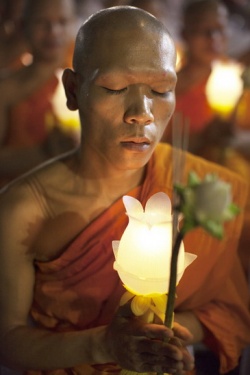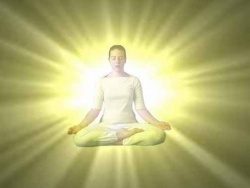Difference between revisions of "The Practicalities of Retreat"
m (Text replacement - "]]]" to "]])") |
|||
| Line 63: | Line 63: | ||
Challenges | Challenges | ||
| − | Difficulties do arise on [[retreat]]. Reading the [[Life]] of the [[Buddha]] or [[Milarepa]], or other well known retreatants can be helpful. They had the same problems we do with {{Wiki|fear}} and resistance. In talking about [[Milarepa's]] [[retreat]] [[obstacles]], the [[Vidyadhara]] [[[Chogyam Trungpa]] | + | Difficulties do arise on [[retreat]]. Reading the [[Life]] of the [[Buddha]] or [[Milarepa]], or other well known retreatants can be helpful. They had the same problems we do with {{Wiki|fear}} and resistance. In talking about [[Milarepa's]] [[retreat]] [[obstacles]], the [[Vidyadhara]] [[[Chogyam Trungpa]]) said that his {{Wiki|fear}} on [[retreat]] was a sign of loneliness. He craved company and brought {{Wiki|fear}} in as a companion. Most of us are used to having all kinds of {{Wiki|distractions}} such as the phone, the television and [[endless]] errands. How often are we totally alone? Do not be discouraged if you find you are [[feeling]] frightened or lonely. |
Latest revision as of 00:26, 5 April 2016
The Practicalities of Retreat
by Melissa Robinson
Retreat is a time to think a lot, and a time to abandon a lot of thoughts.
—Chögyam Trungpa
Solitary retreat remains one of our most poignant practice experiences. To go on retreat is to abandon our usual routine and enter into a world of simplicity, focused meditation practice and inspired contemplation. While solitary retreats are recommended for those truly seeking realization, even those just entering the path will find retreat practice valuable.
These days the boundaries between the secular and religious worlds are melting. Most people go on retreat to deepen not only their appreciation for practice, but also to nurture themselves. Usually one leaves retreat feeling refreshed and renewed and one brings that inspiration into one's life and relationships.
Teachers, past and present, have given advice on retreat based on years of personal experience and observation. In reading some of these treatises, a few consistent themes arise.
Motivation
Put worldly concerns behind you. Enter retreat with the sincere intention to attain unsurpassable great enlightenment.
—Jamgon Kongtrul's Retreat Manual
Before embarking on any retreat, you should know why you are going and what you hope to accomplish. For most student of Tibetan Buddhism, retreat is viewed as a necessary step on the path to liberation. Equipped with detailed instruction for specific practices, they go on retreat to work towards enlightenment, and many people plan long retreats for that express purpose. For most of us though, our early retreats are envisioned ax a time to develop a deeper appreciation of our current practice, or sometimes to get started on a new one. Other times we might seek to accomplish a specific number of mantras or to complete a retreat cycle such as Chakrasamvara or Vajrakilaya.
Preparation
A practice program, such as dathun or sesshin, is an excellent was to prepare for a retreat. During group retreat programs you will gain experience with extended periods of sitting and receive a full measure of meditation instruction.
Sakyong Mipham Rinpoche emphasizes that one should go on retreat when things are relatively smooth. It is not a time to figure out what you are going to do next with your life. To do so you must be able to settle in and not be distracted by too many worldly concerns.
Before leaving for a retreat meet with your teacher, a meditation instructor, or another senior practitioner who regularly does retreats, and get guidelines from them. If you do not have a regular routine of practice and study, it would be good to establish one a few weeks ahead of the retreat. Learn all the procedures, such as the mantras and offerings, so you can do them with confidence. Know the order of the chants, so you can do them with confidence.
Know the order of the chants and find out if there are specific protector chants or rituals for the retreat center where you will be going. Often people go on retreat, which they feel is a precious time, and have to spend half of it just relearning their practice. Gather the food, clothing, bedding and other items you will need for retreat at least a week or so before traveling, Enter retreat feeling prepared, not frazzled by last minute preparations.
Place
Between highlands and lowlands
There are no human footprints,
Which makes this sacred ground for enlightenment
—Jetsun Milarepa
The ideal environment for a retreat is secluded, quiet, safe and someplace where you can meet your basic needs for food, practice and rest. although somewhat isolated, you should have someone nearby who can deliver supplies and render assistance if needed. It should be comfortable yet simple. While many people feel it would be romantic to do a retreat in a cave in Asia, how many of us could really withstand the hardships? Be realistic.
Conduct
Consult your teacher for advice on how many sessions of practice to do each day. Most teachers recommend that you spend part or all of the first day preparing your cabin and getting used to being in retreat before beginning an eight to ten hour daily routine of practice. Newer practitioners might want to start out with fewer hours and lengthen their routine after a few days.
Unlike group retreats where meal planning, preparation and clean-up is arranged, on a solitary retreat you have to do all these things yourself. Leave enough time to do these things properly and enjoyably. They are part of the retreat experience.
As for conduct on retreat, be honest with yourself, and do not set unattainable goals. Define your retreat boundaries both in terms of the physical situation and your needs and then stick to them. Avoid contact with others, but seek out help if needed. Do not fast, go on a radical diet, or give up smoking on retreat. To do so might add unnecessary anxiety.
Commitment
Rigdzin Jigme Lingpa advises that on retreat one should never break one's commitment. For that reason, you should plan the length of your retreat carefully. It is better to schedule a shorter retreat first and ten come back for a longer time, than to do a long retreat and find halfway through that you cannot complete it. Jigme Lingpa goes on to say that one should "take the correct amount of food, balance the length of time you sleep and keep awareness keen."
Your attitude on retreat should be like the Shamatha meditation instruction: not too tight, not too loose. Work with your practice discipline diligently, but be kind to yourself. If you find you are are having great difficulties it is better to seek out advice from the retreat masters than to be stoic and try to tough it out.
Challenges
Difficulties do arise on retreat. Reading the Life of the Buddha or Milarepa, or other well known retreatants can be helpful. They had the same problems we do with fear and resistance. In talking about Milarepa's retreat obstacles, the Vidyadhara [[[Chogyam Trungpa]]) said that his fear on retreat was a sign of loneliness. He craved company and brought fear in as a companion. Most of us are used to having all kinds of distractions such as the phone, the television and endless errands. How often are we totally alone? Do not be discouraged if you find you are feeling frightened or lonely.
For some people, it takes time to get comfortable on retreat. Before his enlightenment, the Buddha felt troubled about leaving his kingdom and young family. For Milarepa it was a dream of his mother's death that disturbed his stability. These great practitioners faced challenges and eventually overcame them we can call on their example for strength and support. Recalling their experiences by reading a book or listening to a seminar can be heartening.
A retreat can also be delightful. Not only can you make progress and have true insights arise, but also real confidence from just learning to make fire or by chopping wood. These experiences should not be minimized; they are part of the retreat too.
There can also be magic on retreat! Having a remarkable insight, seeing your visualization appear on the mountain, or hearing the songs of the coyotes in same melody of your mantra. Everyone has as story to tell.
In this sacred ground of solitary retreat, I, Milarepa, keep to my practice.
—Jetsun Milarepa
Continuity
Just as it is suggested that you prepare for retreat a week or more in advance, it is also important to continue your practice when you get home. Do not cling to the experience of relaxation and clarity you accessed on retreat, but work with it by establishing some continuity in your daily life. After retreat, even short periods of practice or study will feel rewarding.
Review your retreat experience with your teacher or advisor and decide how you might continue investigating that in your life. For instance, you might feel the desire to study more after retreat. Intensive practice often raises as many questions as it answers. While you are still inspired, schedule your next retreat.
If you go to a mountain retreat devoted to your spiritual master, you will attain supreme accomplishment.
—Jamgon Kongtrul




